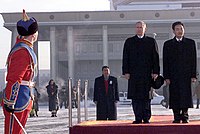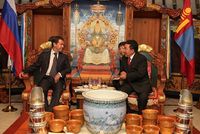Mongolia–Russia relations
 | |
Mongolia |
Russia |
|---|---|
This article may be expanded with text translated from the corresponding article in Russian. (January 2022) Click [show] for important translation instructions.
|
Mongolia–Russia relations (Mongolian: Монгол Оросын харилцаа; Russian: Российско-монгольские отношения) have been traditionally strong since the Communist era, when the Soviet Union supported Mongolian People's Republic. Mongolia and Russia remain allies in the post-communist era. Russia has an embassy in Ulaanbaatar and two consulate generals (in Darkhan and Erdenet). Mongolia has an embassy in Moscow, three consulate generals (in Irkutsk, Kyzyl and Ulan Ude), and a branch in Yekaterinburg. Both countries are full members of the Organization for Security and Co-operation in Europe (Russia is a participating state, while Mongolia is a partner).
According to a 2017 survey, 90% of Mongolians have a favorable view of Russia (38% "strongly" and 52% "somewhat" favorable), with 8% expressing a negative view (2% "strongly" and 6% "somewhat" unfavorable).[1]
Background[]

Russia and Mongolia share a 3,500-kilometer border.[2] When Chinese forces attacked Mongolia in 1919 to negate its independence from China, the Russian Asiatic Cavalry Division commanded by Roman von Ungern-Sternberg helped Mongolia ward off the invasion. The Mongolian People's Republic was established in 1921 with Soviet military support and under Soviet influence.


Soviet Union and the Mongolian People's Republic[]
The Soviet Union supported the revolution which brought the Mongolian People's Party (later the Mongolian People's Revolutionary Party) to power[3] as the ruling party of the Mongolian People's Republic (MPR), established in 1924.[4] Over the next seventy years, Mongolia "pursued policies in imitation of the devised by the USSR" as a Soviet satellite state.[4] Mongolian supreme leader Khorloogiin Choibalsan, acting under Soviet instructions, carried out a mass terror from 1936 to 1952 (see Stalinist repressions in Mongolia), with the greatest number of arrests and executions (targeting in particular the Buddhist clergy) occurring between September 1937 and November 1939.[3] Soviet influences pervaded Mongolian culture throughout the period, and schools through the nation, as well as the National University of Mongolia, emphasized Marxism-Leninism.[3] Nearly every member of the Mongolian political and technocratic elite, as well as many members of the cultural and artistic elite, were educated in the USSR or one of its Eastern European allies.[4] The Mongolian economy was heavily reliant on the Soviet bloc for electric power, trade, and investment.[4] The MPR collapsed in 1990 and the first democratically elected government took office the same year, leading to "a wedge in the previously close relationship between Mongolia and the Soviet bloc."[4] After 1992, Russian technical aid stopped, and Russia made a request to Mongolia to pay back all the aid which it had received from the Soviet Union from 1946 to 1990, a figure which the Soviets estimated at 11.6 billion Soviet transferable rubles (disputed by the Mongolians).[5]
The communist regimes of Mongolia and the USSR forged close bilateral relations and cooperation.[2][6] Both nations established close industrial and trade links, especially with the Soviet republics in Central Asia and Mongolia consistently supported the Soviet Union on international issues.[6] Mongolia sought Russian aid to allay fears of Chinese expansionism and a large number of Soviet forces were permanently deployed in Mongolia.[7] In 1986, both countries signed a treaty of peace, friendship and cooperation.[6] Mongolia sided with the Soviet Union following the Sino-Soviet split in the 1950s. Following the example of Soviet leader Mikhail Gorbachev's policy of improving ties with the West and China, Mongolia improved its relations with the United States and China.[6] In 1989, Mongolia and the Soviet Union finalized plans for the withdrawal of Soviet troops from Mongolia.[6]
Contemporary times[]
Following the dissolution of the Soviet Union and the end of the first Cold War, Mongolia's trade with Russia declined by 80% and China's relations and influence over Mongolia increased.[7] However, Russia has sought to rebuild strong relations with Mongolia in recent years to enhance its standing as a regional power.[7] In 2000, then Russian President Vladimir Putin made a landmark visit to Mongolia —the first by a Russian head of state since Leonid Brezhnev in 1974[8] and one of the first of Putin's presidency— and renewed a major bilateral treaty.[2][7] The visit and improvement in bilateral relations was popularly welcomed in Mongolia as countering China's influence.[7] Russia lowered the prices of oil and energy exports to Mongolia and enhanced cross-border trade.[7] The Russian government wrote off 98% of Mongolia's state debt and an agreement was signed to build an oil pipeline from Russia to China through Mongolia.[2]
State visits[]
From Soviet and Russian leaders to Mongolia[]
- Leonid Brezhnev (13-15 January 1966)[9]
- Leonid Brezhnev (November 1974)[10]
- Vladimir Putin (2000)
- Dmitry Medvedev (2-3 September 2009)
- Vladimir Putin (2-3 September 2014)
- Vladimir Putin (2-3 September 2019)
From Mongolian leaders to Russia[]
- Damdin Sükhbaatar (1921)
- Punsalmaagiin Ochirbat (1993)
- Natsagiin Bagabandi (1999)
- Natsagiin Bagabandi (9 May 2005)
- Nambaryn Enkhbayar (2006)
- Nambaryn Enkhbayar (2008)
- Tsakhiagiin Elbegdorj (9 May 2010)[11]
- Tsakhiagiin Elbegdorj (31 May 2011)
- Tsakhiagiin Elbegdorj (9 May 2015)[12]
- Khaltmaagiin Battulga (7 September 2017)
Gallery[]

Natsagiyn Bagabandi with Vladimir Putin in 2000.

Nambaryn Enkhbayar with Vladimir Putin in 2005.

Dimitry Medvedev with Tsakhiagiin Elbegdorj.

Dimitry Medvedev with Tsakhiagiin Elbedorj in 2009

Khaltmaagiin Battulga with Vladimir Putin in 2017.
See also[]
- Battle of Kulikovo
- Foreign relations of Mongolia
- Foreign relations of Russia
- Mongolia–Russia border
- Mongol invasion of Kievan Rus'
References[]
- ^ "Pre-Presidential Election National Survey of Mongolian Public Opinion" (PDF). iri.org. July 23, 2018.
- ^ a b c d Blagov, Sergei (May 2005). "Mongolia Drifts Away From Russia Toward China". China Brief. The Jamestown Foundation. 5 (10). Archived from the original on March 22, 2007. Retrieved 2008-06-16.
- ^ a b c Balazs Szalontai, "From the Demolition of Monasteries to the Installation of Neon Lights: The Politics of Urban Construction in the Mongolian People's Republic" in Sites of Modernity: Asian Cities in the Transitory Moments of Trade, Colonialism, and Nationalism (ed. Wasana Wongsurawat), pp. 165-66.
- ^ a b c d e Morris Rossabi, Modern Mongolia: From Khans to Commissars to Capitalists (University of California Press, 2005), pp. 31-37.
- ^ Alan J. K. Sanders, "Russia: Relations With Mongolia" in Historical Dictionary of Mongolia (3d ed.: Scarecrow Press, 2010), pp. 616-23.
- ^ a b c d e "Mongolia — Soviet relations". Library of Congress. Retrieved 2008-06-17.
- ^ a b c d e f "Russia Seeks To Restore Position in Mongolia As Most Favored Neighbor". Eurasianet.org. 2000-11-17. Archived from the original on 2017-08-31. Retrieved 2008-06-17.
- ^ Montsame News Agency. Mongolia. 2006, Foreign Service Office of Montsame News Agency, ISBN 99929-0-627-8, p. 55
- ^ "Wilson Center Digital Archive".
- ^ "Soviet Helps Mongolia Shed Feudalism". The New York Times. 14 December 1974.
- ^ "Foreign heads of state, governments and international organisations participating in the celebration of the 65th Anniversary of the Victory". Presidential Press and Information Office. 9 May 2010. Retrieved 9 May 2010.[dead link]
- ^ Lucy Westcott (May 9, 2015). "Russia flexes military might as foreign leaders stay away from V-E parade". Newsweek. Archived from the original on 10 May 2015. Retrieved May 10, 2015.
External links[]
| Wikimedia Commons has media related to Relations of Mongolia and Russia. |
- (in Russian) Documents on the Mongolia–Russia relationship at the Russian Ministry of Foreign Affairs
Diplomatic missions[]
- (in Russian, English, and Mongolian) Embassy of Russia in Ulan Batar
- (in Russian, English, and Mongolian) Embassy of Mongolia in Moscow
- Mongolia–Russia relations
- Bilateral relations of Mongolia
- Bilateral relations of Russia






